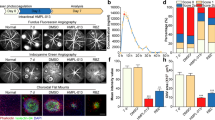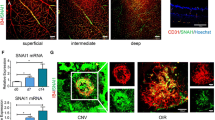Abstract
Stromal derived factor (SDF)-1 has been confirmed to regulate angiogenesis in choroidal neovascularization formation via its two receptors, CXC chemokine receptors 4 (CXCR4) and 7 (CXCR7). Previous studies found that there is cross-talk between the transforming growth factor beta (TGF-β) and SDF-1 pathways in some types of immune or tumor cells, but much less is known about this interaction in endothelial cells. This study investigated the effects of TGF-β1 on CXCR4 and CXCR7 expression as well as SDF-1-induced migration and tube formation in choroid-retinal endothelial (RF/6A) cells. RF/6A cells were treated with recombinant TGF-β1 at various concentrations and time points. Real-time PCR and Western blotting were used to examine the mRNA and protein levels of CXCR4 and CXCR7. In addition, transwell migration and Matrigel tube formation analyses were performed to investigate the role of TGF-β1 pretreatment in SDF-1-induced RF/6A cell migration and tube formation. Our results showed that treatment with recombinant human TGF-β1 enhanced the CXCR4 and CXCR7 levels in time- and dose-dependent manners. The increased CXCR4 and CXCR7 expression resulted in increased SDF-1-induced RF/6A cell migration and tube formation. In addition, the transcriptional regulation of CXCR4 and CXCR7 by TGF-β1 was found to be mediated by phosphorylation of the extracellular signal-related kinase1/2 pathway. Altogether, these results demonstrate that a cross-talk exists between the TGF-β1 and SDF-1 pathways in choroid-retinal endothelial cells, reflecting a novel molecular mechanism that explains the pro-angiogenic effects of TGF-β1 and possibly provides new perspectives for the treatment of CNV-associated diseases.




Similar content being viewed by others
References
Friedman DS, O’Colmain BJ, Munoz B, Tomany SC, McCarty C, de Jong PT, Nemesure B, Mitchell P, Kempen J (2004) Prevalence of age-related macular degeneration in the United States. Arch Ophthalmol 122:564–572
Wong TY, Loon SC, Saw SM (2006) The epidemiology of age related eye diseases in Asia. Br J Ophthalmol 90:506–511
Tong JP, Yao YF (2006) Contribution of VEGF and PEDF to choroidal angiogenesis: a need for balanced expressions. Clin Biochem 39:267–276
de Oliveira DJ, Rodrigues EB, Maia M, Magalhaes OJ, Penha FM, Farah ME (2011) Cytokines in neovascular age-related macular degeneration: fundamentals of targeted combination therapy. Br J Ophthalmol 95:1631–1637
Burns JM, Summers BC, Wang Y, Melikian A, Berahovich R, Miao Z, Penfold ME, Sunshine MJ, Littman DR, Kuo CJ, Wei K, McMaster BE, Wright K, Howard MC, Schall TJ (2006) A novel chemokine receptor for SDF-1 and I-TAC involved in cell survival, cell adhesion, and tumor development. J Exp Med 203:2201–2213
Balabanian K, Lagane B, Infantino S, Chow KY, Harriague J, Moepps B, Arenzana-Seisdedos F, Thelen M, Bachelerie F (2005) The chemokine SDF-1/CXCL12 binds to and signals through the orphan receptor RDC1 in T lymphocytes. J Biol Chem 280:35760–35766
Bleul CC, Fuhlbrigge RC, Casasnovas JM, Aiuti A, Springer TA (1996) A highly efficacious lymphocyte chemoattractant, stromal cell-derived factor 1 (SDF-1). J Exp Med 184:1101–1109
Zhang ZX, Wang YS, Shi YY, Hou HY, Zhang C, Cai Y, Dou GR, Yao LB, Li FY (2011) Hypoxia specific SDF-1 expression by retinal pigment epithelium initiates bone marrow-derived cells to participate in Choroidal neovascularization in a laser-induced mouse model. Curr Eye Res 36:838–849
Dai X, Tan Y, Cai S, Xiong X, Wang L, Ye Q, Yan X, Ma K, Cai L (2011) The role of CXCR7 on the adhesion, proliferation and angiogenesis of endothelial progenitor cells. J Cell Mol Med 15:1299–1309
Roberts AB, Flanders KC, Kondaiah P, Thompson NL, Van Obberghen-Schilling E, Wakefield L, Rossi P, de Crombrugghe B, Heine U, Sporn MB (1988) Transforming growth factor beta: biochemistry and roles in embryogenesis, tissue repair and remodeling, and carcinogenesis. Recent Prog Horm Res 44:157–197
Sporn MB, Roberts AB (1992) Transforming growth factor-beta: recent progress and new challenges. J Cell Biol 119:1017–1021
Ogata N, Yamamoto C, Miyashiro M, Yamada H, Matsushima M, Uyama M (1997) Expression of transforming growth factor-beta mRNA in experimental choroidal neovascularization. Curr Eye Res 16:9–18
Yamanaka R, Ogata N, Yamamoto C, Matsushita M, Matsuzaki K, Uyama M, Matsumura M (2002) Expression of transforming growth factor-beta receptors in normal rat retina and experimental choroidal neovascularization. Jpn J Ophthalmol 46:525–532
Nagineni CN, Samuel W, Nagineni S, Pardhasaradhi K, Wiggert B, Detrick B, Hooks JJ (2003) Transforming growth factor-beta induces expression of vascular endothelial growth factor in human retinal pigment epithelial cells: involvement of mitogen-activated protein kinases. J Cell Physiol 197:453–462
Amin R, Puklin JE, Frank RN (1994) Growth factor localization in choroidal neovascular membranes of age-related macular degeneration. Invest Ophthalmol Vis Sci 35:3178–3188
Bertran E, Caja L, Navarro E, Sancho P, Mainez J (2009) Murillo MM, Vinyals A, Fabra A, Fabregat I: Role of CXCR4/SDF-1 alpha in the migratory phenotype of hepatoma cells that have undergone epithelial-mesenchymal transition in response to the transforming growth factor-beta. Cell Signal 21:1595–1606
Lou DA, Hu FN (1987) Specific antigen and organelle expression of a long-term rhesus endothelial cell line. In Vitro Cell Dev Biol 23:75–85
Watanabe K, Penfold ME, Matsuda A, Ohyanagi N, Kaneko K, Miyabe Y, Matsumoto K, Schall TJ, Miyasaka N, Nanki T (2010) Pathogenic role of CXCR7 in rheumatoid arthritis. Arthritis Rheum 62:3211–3220
Jin J, Zhao WC, Yuan F (2013) CXCR7/CXCR4/CXCL12 axis regulates the proliferation, migration, survival and tube formation of choroid-retinal endothelial cells. Ophthalmic Res 50:6–12
Pardali E, Goumans MJ, Ten DP (2010) Signaling by members of the TGF-beta family in vascular morphogenesis and disease. Trends Cell Biol 20:556–567
Franitza S, Kollet O, Brill A, Vaday GG, Petit I, Lapidot T, Alon R, Lider O (2002) TGF-beta1 enhances SDF-1alpha-induced chemotaxis and homing of naive T cells by up-regulating CXCR4 expression and downstream cytoskeletal effector molecules. Eur J Immunol 32:193–202
Bertran E, Crosas-Molist E, Sancho P, Caja L, Lopez-Luque J, Navarro E, Egea G, Lastra R, Serrano T, Ramos E, Fabregat I (2013) Overactivation of the TGF-beta pathway confers a mesenchymal-like phenotype and CXCR4-dependent migratory properties to liver tumor cells. Hepatology 58:2032–2044
Boldajipour B, Mahabaleshwar H, Kardash E, Reichman-Fried M, Blaser H, Minina S, Wilson D, Xu Q, Raz E (2008) Control of chemokine-guided cell migration by ligand sequestration. Cell 132:463–473
Kang Y (2006) Pro-metastasis function of TGFbeta mediated by the Smad pathway. J Cell Biochem 98:1380–1390
Acknowledgments
This study was supported by grants from the National Nature Science Foundation of China (No. 81470637, http://www.nsfc.gov.cn) and the Open Fund of the Key Laboratory of Carcinogenesis and Cancer Invasion, Fudan University, Ministry of Education (No. KLCCI2014-1). The authors thank Dr. Mohammad Javed Ali for his help on the manuscript.
Author information
Authors and Affiliations
Corresponding author
Rights and permissions
About this article
Cite this article
Feng, Yf., Yuan, F., Guo, H. et al. TGF-β1 enhances SDF-1-induced migration and tube formation of choroid-retinal endothelial cells by up-regulating CXCR4 and CXCR7 expression. Mol Cell Biochem 397, 131–138 (2014). https://doi.org/10.1007/s11010-014-2180-6
Received:
Accepted:
Published:
Issue Date:
DOI: https://doi.org/10.1007/s11010-014-2180-6




